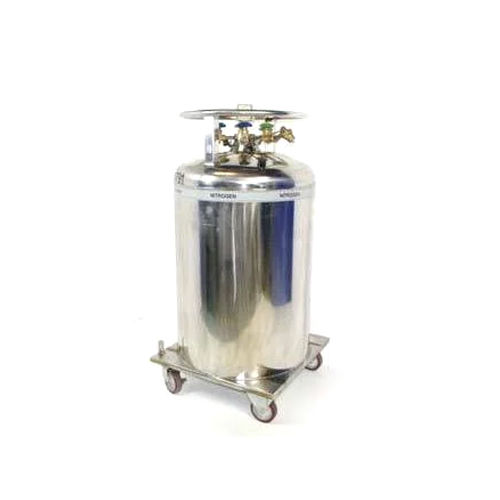Liquid Nitrogen Gas Cylinder
Product Details:
- Purity High
- Industries Oil And Gas
- Air Gases Nitrogen
- Application Commercial
- Click to View more
Liquid Nitrogen Gas Cylinder Price And Quantity
- 1500 INR/Piece
- 20 Piece
Liquid Nitrogen Gas Cylinder Product Specifications
- Oil And Gas
- Nitrogen
- High
- Commercial
Liquid Nitrogen Gas Cylinder Trade Information
- Cash Advance (CA)
- 1000 Piece Per Month
- 10 Days
- All India
Product Description
A container for storing and moving liquid nitrogen is a liquid nitrogen gas cylinder. Usually composed of steel or aluminium, the cylinder is insulated to stop heat loss. The liquid nitrogen can be dispensed from the cylinder thanks to a valve.
Applications for liquid nitrogen gas cylinders include research labs, healthcare facilities and industrial environments. Liquid nitrogen is kept and moved in the cylinders for a variety of uses, including cooling equipment, running experiments, and cryogenically preserving samples.
Safety measures must be taken when using a liquid nitrogen gas cylinder to prevent exposure to the extremely cold liquid nitrogen. To prevent leaks, the cylinder should be handled cautiously. Keeping the cylinder away from heat sources will also help keep the liquid nitrogen from boiling.
The following are some safety measures to follow when using a liquid nitrogen gas cylinder:
- To handle the cylinder safely, put on gloves and safety eyewear.
- Keep heat sources away from the cylinder.
- Avoid getting the cylinder close to your skin or eyes.
- If the cylinder leaks, leave the area right away and open the windows to the outside.
When utilising a liquid nitrogen gas cylinder, you may assist avoid accidents and injuries by using these safety steps.
The following are some things to take into account while selecting a liquid nitrogen gas cylinder:
- Capacity: The cylinder needs to have the right amount of capacity for the job.
- Material: The cylinder should be constructed of a substance that can withstand the liquid nitrogen's extremely low temperature.
- The cylinder needs to be insulated to stop heat loss.
- Valve: The valve needs to be simple to use and leak-proof in design.
- Cost: Depending of the cylinder's volume, material, insulation, and valve, the price will change.
You may select a liquid nitrogen gas cylinder that is reliable and safe for your application by taking these considerations into account.
The following are a few applications for liquid nitrogen gas cylinders:
- Liquid nitrogen can be used to chill equipment, including microscopes and lasers.
- Liquid nitrogen is a versatile tool that can be used to conduct research in a number of disciplines, including physics, chemistry, and biology.
- Cryogenically preserving samples: Cells, tissues, and organs can be cryogenically preserved using liquid nitrogen.
Liquid nitrogen may be stored and transported safely and efficiently in liquid nitrogen gas cylinders. You can select a liquid nitrogen gas cylinder that is ideal for your requirements by adhering to the safety precautions and taking into account the criteria mentioned above.
FAQ
1. What exactly is a pressure cylinder for liquid nitrogen?
Ans - A storage container used to hold liquid nitrogen under pressure is called a liquid nitrogen pressure cylinder. Typically, it consists of an interior vessel encased in an insulation layer and a housing for protection. The vessel is made to keep the nitrogen's pressure and temperature at a safe level while holding a predetermined amount of liquid nitrogen.
2. What safety precautions should be taken when handling pressure cylinders of liquid nitrogen?
Ans - Pressure cylinders for liquid nitrogen need to be handled carefully and in accordance with the manufacturer's recommendations. When working with a liquid nitrogen pressure cylinder, it's imperative to put on safety gear such thick gloves, goggles, and shoes. Additionally, they want to keep their skin away from the liquid nitrogen.
3. How should a pressure cylinder for liquid nitrogen be stored?
Ans - A liquid nitrogen pressure cylinder should be kept out of the direct sunshine, heat sources like radiators, and air conditioning systems. It should also be safely secured to a wall or other sturdy surface and kept in a dry place.
4. How frequently should a pressure cylinder for liquid nitrogen be inspected?
Ans - A liquid nitrogen pressure cylinder needs to be checked frequently for any indications of corrosion, leaks, or other damage. It is advised that the cylinder be examined by trained professionals at least once a year.
5. What is the safest technique to get rid of a pressure cylinder of liquid nitrogen?
Ans - Making contact with a waste removal business that specialises in hazardous materials disposal is the safest approach to get rid of a liquid nitrogen pressure cylinder. They ought to be able to properly dispose of the cylinder in accordance with all regional laws.
Other Products in 'Nitrogen Cylinder' category
 |
THIRUMALAI ATMOSPHERIC PRODUCTS
All Rights Reserved.(Terms of Use) Developed and Managed by Infocom Network Private Limited. |
 Send SMS
Send SMS

